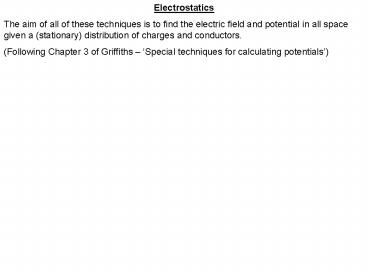Electrostatics - PowerPoint PPT Presentation
1 / 13
Title:
Electrostatics
Description:
Electrostatics ... (Following Chapter 3 of Griffiths Special techniques for calculating potentials' ... Ultimately we are usually interested in finding the ... – PowerPoint PPT presentation
Number of Views:41
Avg rating:3.0/5.0
Title: Electrostatics
1
Electrostatics The aim of all of these techniques
is to find the electric field and potential in
all space given a (stationary) distribution of
charges and conductors. (Following Chapter 3 of
Griffiths Special techniques for calculating
potentials)
2
2.1 Laplaces Equation Ultimately we are usually
interested in finding the electric field in a
given situation so can we use Coulombs
Law? Technically yes, but it is very hard to
calculate for an arbitrary charge
distribution. It is typically easier to calculate
the potential first The easiest of all is to
use Poissions Equation
3
We will look at cases where ? 0 i.e. no
charge within the region of interest Lapla
ces Equation
4
2.2 Revision The Physics Behind Laplaces
Equation Gausss Law The flux from a collection
of charges only depends on the amount of charge
in that closed region. Now, from the divergence
theorem So ? And differential form of
Gausss Theorem
5
Definition of potential V The work per unit
charge So, combining this with the
differential form of Gausss Theorem we get
Poissons Equation
6
2.3 Solving Laplaces Equation in
1-dimension Example Find the potential inside a
parallel-plate capacitor given the boundary
conditions of V(x0) 0 and V(xx1) V1.
7
2.3 Solving Laplaces Equation in
1-dimension Example Find the potential inside a
parallel-plate capacitor given the boundary
conditions of V(x0) 0 and V(xx1) V1. So we
see that the solution to Laplaces Equation,
together with the boundary conditions, specifies
a unique solution. Solving Laplaces Equation
alone does not allow you to find the solution,
the potential V everywhere.
8
2.4 Uniqueness This result raises an important
question If we have found (by any means we like)
a solution that solves Laplaces equation and
fits the specified boundary conditions, is it the
only correct solution to the problem?
9
2.4 Uniqueness This result raises a couple of
important questions If we have found (by any
means we like) a solution that solves Laplaces
equation and fits the specified boundary
conditions, is it the only correct solution to
the problem? What boundary conditions do we have
to know/specify in order to find a unique
solution?
10
2.4 Uniqueness This result raises a couple of
important questions If we have found (by any
means we like) a solution that solves Laplaces
equation and fits the specified boundary
conditions, is it the only correct solution to
the problem? What boundary conditions do we have
to know/specify in order to find a unique
solution? So the answer is yes, if its a
solution of the equation and the boundary
conditions (in some form) are met then it is the
unique correct solution.
11
2.4 Solving Laplaces Equation in 2-dimensions In
this case we are looking for a solution
to However, as this is a second order partial
differential equation we cannot write down a
closed-form solution like we could for the 1-d
case. We can, however, deduce some of the common
properties of all of the solutions to the
equation
12
2.4 Solving Laplaces Equation in 2-dimensions In
this case we are looking for a solution
to However, as this is a second order partial
differential equation we cannot write down a
closed-form solution like we could for the 1-d
case. We can, however, deduce some of the common
properties of all of the solutions to the
equation
- The value of V at a point (x,y) is the average of
those around the point - So, in-turn this implies is that there can be no
local minima or maxima all extrema must occur at
the boundaries.
13
Example Find the potential within the following
square cross-section channel and sketch-in
several equipotentials































